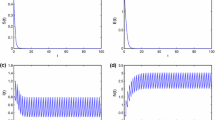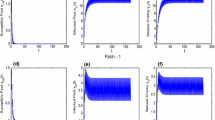Abstract
According to biological and chemical control strategy for pest control, we investigate an SI model for pest management, concerning periodic spraying of microbial pesticide and releasing infected pests at different fixed moments. By using Floquet and comparison theorems, we prove that the pest-extinction periodic solution is globally asymptotically stable when the impulsive period T is less than the critical value T max . Otherwise, the system can be permanent. Our results provide reliable tactic basis for the practical pest management.
Similar content being viewed by others
References
Anderson, R., May, R.: Infectious Diseases of Human: Dynamics and Control. Oxford University Press, Oxford (1991)
Bainov, D.D., Simeonov, P.S.: System with Impulse Effect, Theory and Applications. Ellis Harwood Series in Mathematics and its Applications. Ellis Harwood, Chichester (1993)
Barclay, H.J.: Models for pest control using predator release, habitat management and pesticide release in combination. J. Appl. Ecol. 19, 337–348 (1982)
Bean, S.: Management and Analysis of Biological Populations. Elsevier, Amsterdam (1980)
Grasman, J., Van Herwaarden, O.A., Hemerik, L., Van Lenteren, J.C.: A two-component model of host–parasitoid interactions: determination of the size of inundative releases of parasitoids in biological pest control. Math. Biosci. 169, 207–216 (2001)
Georgescu, P., Moroşanu, G.: Pest regulation by means of impulsive controls. Appl. Math. Comput. 190, 790–803 (2007)
Huffaker, C.B.: New Technology of Pest Control. Wiley, New York (1980)
Hethcote, H.: The mathematics of infectious disease. SIAM Rev. 42, 599–653 (2002)
Jiao, J.J., Chen, L.S.: A stage-structured Holling mass defence predator-prey model with impulsive perturbations on predators. Appl. Math. Comput. 189, 1448–1458 (2007)
Jiao, J.J., Chen, L.S., Luo, G.L.: An appropriate pest management SI model with biological and chemical control concern. Appl. Math. Comput. 196(1), 285–293 (2008)
Liu, W.M., Levin, S.A., Lwasa, Y.: Influence of nonlinear rates upon the behavior of SIRS epidemiological models. J. Math. Biol. 23, 187–204 (1986)
Liu, W.M., Hethcote, H.W., Levin, S.A.: Dynamical behavior of epidemiological models with nonlinear incidence rates. J. Math. Biol. 25, 359–380 (1987)
Lakshmikantham, V., Bainov, D.D., Simeonov, P.S.: Theory of Impulsive Differential Equations. Singapore, World Scientific (1989)
Pang, G.P., Chen, L.S.: Dynamic analysis of a pest-epidemic model with impulsive control. Math. Comput. Simul. 79(1), 72–84 (2008)
Tang, S.Y., Xiao, Y.N., Chen, L.S., Cheke, R.A.: Integrated pest management models and their dynamical behavior. Bull. Math. Biol. 67, 115–135 (2005)
VanLenteren, J.C.: Integrated pest management in protected crops. In: Dent, D. (ed.) Integrated Pest Management, pp. 311–320. Chapman and Hall, London (1995)
Wang, X., Song, X.Y.: Mathematical models for the control of a pest population by infected pest. Comput. Math. Appl. 56, 266–278 (2008)
Wang, X., Song, X.Y.: Analysis of an impulsive pest management SEI model with nonlinear incidence rate. Comput. Appl. Math. 29(1), 1–17 (2010)
Zhang, X.A., Chen, L.S.: The periodic solution of a class of epidemic models. Comput. Math. Appl. 38, 61–71 (1999)
Author information
Authors and Affiliations
Corresponding author
Additional information
This work is supported by the National Natural Science Foundation of China (No. 10471117), the Natural Science Foundation of the Education Department of Henan Province (No. 2010B110021), the Young Backbone Teacher Foundation of Xinyang Normal University.
Rights and permissions
About this article
Cite this article
Wang, X., Tao, Y. & Song, X. Analysis of pest-epidemic model by releasing diseased pest with impulsive transmission. Nonlinear Dyn 65, 175–185 (2011). https://doi.org/10.1007/s11071-010-9882-4
Received:
Accepted:
Published:
Issue Date:
DOI: https://doi.org/10.1007/s11071-010-9882-4




